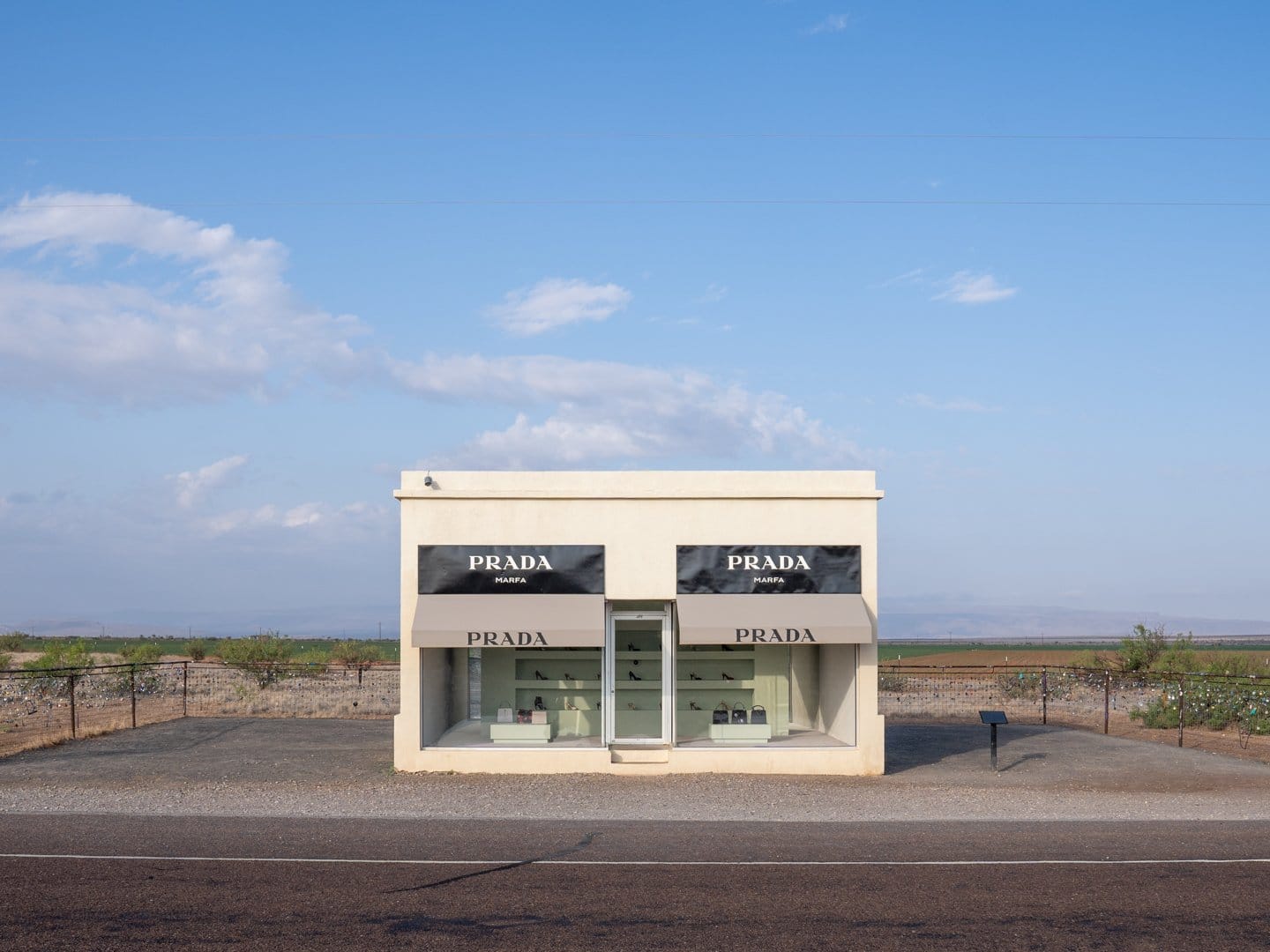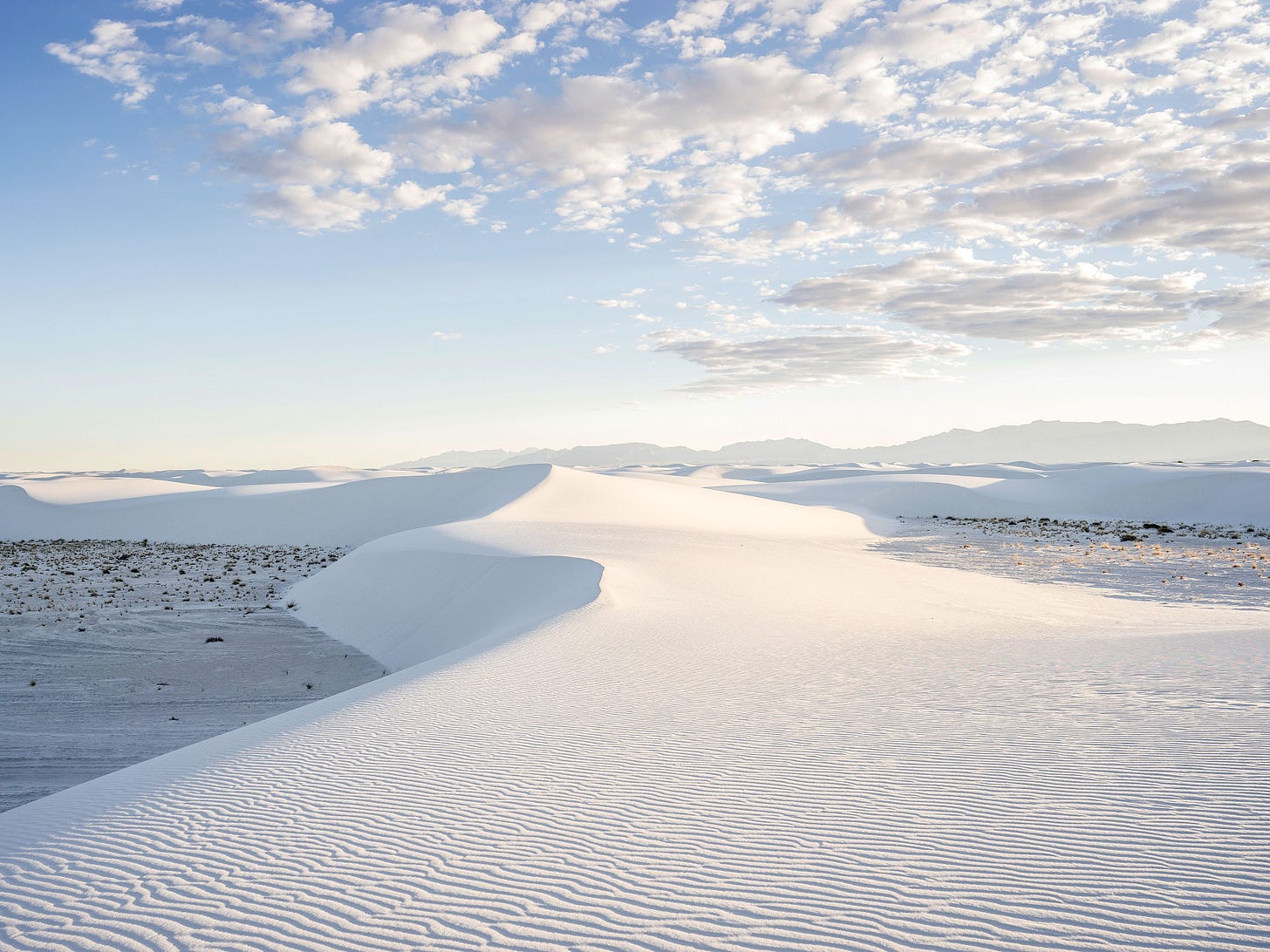Gerry (dir. Gus Van Sant, 2002)
I’ve been thinking about the desert recently. Specifically the desert in the American Southwest. Not really sure why, but it’s been on my mind. I just started reading Death Comes for the Archbishop, Willa Cather’s novel about Catholic missions in New Mexico:
The sky was as full of motion and change as the desert beneath it was monotonous and still, — and there was so much sky, more than at sea, more than anywhere else in the world. The plain was there, under one’s feet, but what one saw when one looked about was that brilliant blue world of stinging air and moving cloud. Even the mountains were mere ant-hills under it. Elsewhere the sky is the roof of the world; but here the earth was the floor of the sky. The landscape one longed for when one was away, the thing all about one, the world one actually lived in, was the sky, the sky!
Thinking about the desert is not necessarily unusual for me, but for some reason I’ve been thinking about it more and more recently. Perhaps it’s because I can drive now, and driving is part of the desert experience, part of the ideology of the open road, the spurious freedom promised by American culture. Back when I lived in the US, I seemed to find myself in the Southwest more than I had expected: I went to a conference on Samuel Beckett in Phoenix, Arizona, of all places; I went with my father and brother to Las Vegas, where we went to a shooting range and drove around in the Nevada desert, going out to see the Hoover Dam, and then in Spring 2017, my mother and I went to New Mexico and Texas, from Albuquerque to Austin with detours to Taos, White Sands, and Marfa. One of my favourite books I’ve read in the last few years has been Stanley Crawford’s A Garlic Testament, which is about his experiences running a small garlic farm in Dixon, NM, about an hour north of Santa Fe. I’ve been thinking about the desert recently because I’ve been thinking about places where it seems like nothing happens; big empty expanses with roads cutting through them, where it’s hard to get a sense of the actual experience of the scattered lives that are spent there. There’s a link in my mind between the desert and the moorlands of Staffordshire and Derbyshire and the big, sparsely occupied expanses of central Wales. Of course, things do happen in these places, people live there, and they’re more than just enjoyable vessels for fantasy and projection. These places are sites of historic conflict around land access and ownership and resources and they’re places of violence and displacement and often places used for the development of military technology (in the 1950s, tourists in Las Vegas could watch atomic bombs being tested from their hotel rooftops) are all unique in their specificities. The Chihuahuan Desert is not the same as the part of Staffordshire just north of Leek, obviously.
Anyway, yesterday I watched Gerry (dir. Gus Van Sant, 2002), which is on Mubi at the moment. In my last Substack post, I wrote that I didn’t know how many people were here for film recommendations, and a couple of people unsubscribed, complaining that I didn’t write about films anymore. Fair enough! I’m writing about a film now, or I’m about to write about a film, but they won’t know about it, because they already unsubscribed. Their loss. It’s been hot here the last week or so. Nothing outlandish for the time of year — 28, 29ºC — we’re not quite in the record-breaking heatwave part of the year yet. L is at the very tail-end of finishing her book manuscript and is working flat out and at odd hours. Yesterday, Sunday, we were both a bit unsure of how to spend our time; it was too hot in the flat, too busy in the parks, I wanted to go for a walk but it was too hot for that too, I’m sick of walking to Forge Dam and back and I couldn’t think of where else to go; the kind of day where it’s easy to get a bit fractious and agitated and sad. We ate a nice salad at lunch but the afternoon loomed a bit. Eventually, after I tried an abortive loop of Endcliffe Park, we managed to get to the Botanical Gardens where I lay down with my eyes closed after rereading the first third of an essay in the LRB that I’ve been looking at without interest for a few days. There hasn’t been as many swifts this year as in previous summers; I’ve been keeping my eyes open, and yesterday, early evening, I saw a couple of them flying around. Just a couple of them, though. Not as many as there should be. It got overcast at about six and there was a bit of distant thunder, but no rain. L worked on her book. I looked at some Imogen Cunningham photographs of cacti and succulents and then made some courgette pasta. Afterwards we watched Gerry. We were going to watch Donkey Skin, by Jacques Demy, but we watched Gerry instead. Maybe because I couldn’t be bothered to try and find a way of watching Donkey Skin.
While we watched Gerry I was thinking that it’s a shame that the film diary is over, because it’s exactly the kind of thing I would have enjoyed writing about there. Oh well. I’m glad it’s done, ultimately. I’m still not really watching many films. But I liked Gerry, which is extremely derivative, in a way, but it’s derivative of things that I like, so I think it’s fine. Gus Van Sant had been watching a bunch of Béla Tarr and Chantal Akerman films and decided to make one of his own. Maybe he’d read a bit of Beckett too. Gerry is a film about two men called Gerry, played by Matt Damon and Casey Affleck, who get lost in the desert. Lots of long, slow shots of the two of them walking around, not speaking, feet crunching away in the dirt. It’s kind of insufferable at points, but I like that Matt Damon and Casey Affleck were up for making a kind-of experimental film like this in the early 2000s. I say ‘kind-of experimental’ because the aesthetic experiment at the heart of Gerry — trying out long takes, silence, minimal action, etc — had already been done by other filmmakers, by Tarr and Akerman and whoever else, and, in strictly aesthetic terms, Van Sant isn’t really running the risk of the experiment failing. I think that for something to meaningfully be ‘an experiment’ as an artwork, it has to run the risk of being an unsuccessful experiment. Van Sant knows, having seen Tarr’s and Akerman’s films, that you can get away with long, slow takes. That’s what it feels like — he’s trying to get away with something he already knows he will get away with. Similar to Elephant, in which he rehashes the bold aesthetic experiment that Alan Clarke had developed in his own film called Elephant, Van Sant is picking up aesthetic techniques without needing to worry if they’ll do what he needs. Nothing wrong with that, perhaps. Every artist steals, or puts to use the tools that others have created. It seems like there’s very little risk for Van Sant in making something like Gerry, other than the risk that nobody will come see his film, whereas watching Jeanne Dielman feels like watching Akerman really take some risks, especially when you remember how young she was when she made it. Probably after Good Will Hunting and Finding Forrester Van Sant knew that he could get away with a more financially risky proposition, like Gerry. It doesn’t seem to have done his career any harm. I read that he cited Tomb Raider as an influence on the film — Béla Tarr meets Tomb Raider, he says — and while I think that’s kind of cute, it makes me wonder if he was aware of Peggy Ahwesh’s She Puppet, which was made around the same kind of time, maybe slightly earlier. Apparently Van Sant originally wanted Gerry to feel like “a John Cassavetes film in the desert,” which presumably would have involved more yelling and more stressful close-ups, and which is exactly the kind of thing I’d like to watch. But I liked Gerry, such as it is. It’s kind of like an American version of the European filmmaker going to the desert and getting freaked out; like a homegrown Zabriskie Point or something, an American trying to see America like a European. There’s a good monologue from Casey Affleck where he describes a video game he’s been playing that sounds like a mixture of Civilisation and Age of Empires. The landscape cinematography is very satisfying. I suppose if it fails in anyway, it’s in feeling a bit underwhelming — it uses the techniques of Tarr and Akerman but doesn’t necessarily achieve much with them, perhaps because there’s less risk here. A long, agonising shot of Jeanne Dielman preparing potatoes — or some of the ceaseless trudges down muddy tracks in Tarr’s oeuvre — has the potential to reveal something quite significant to the viewer. At least that’s how I’ve experienced those films; the slowness is there for a reason. In Gerry, it’s a bit like Van Sant has thought that the technique alone is sufficient to produce a response in the viewer, but it feels sometimes like he just found a nice bit of desert and let the camera roll while Damon and Affleck amble through the shot. Perhaps that’s a bit unfair. Yes, It’s not Van Sant’s best work, but I did enjoy it a lot — partially because it’s kind of annoying. L recently told me she thinks I should write a book, maybe a treatise, on the aesthetics of irritation, and I should call it On Being Annoying. Maybe Gerry will get a mention in there.






